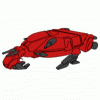Psychie
Princess Psychie
Mecha and Equipment will go here.
Follow along with the video below to see how to install our site as a web app on your home screen.

Note: This feature currently requires accessing the site using the built-in Safari browser.






 Captain Dale Shumer is the commander of Anton-17. A old hand that has served in the RDF from its inception, he is a fair minded and easy going man. His battlefield experience has been as a infantry commander, and has not yet managed to kick the dust off of his boots from the days of marching into combat with his troops. He is well respected by all the solders at Anton-17.
Captain Dale Shumer is the commander of Anton-17. A old hand that has served in the RDF from its inception, he is a fair minded and easy going man. His battlefield experience has been as a infantry commander, and has not yet managed to kick the dust off of his boots from the days of marching into combat with his troops. He is well respected by all the solders at Anton-17. Second Lieutenant Maxwell Danfield is the man in charge of making sure your mecha are always ready to be deployed. A master scrounger, Max knows enough people in the right places to be able to keep the machines under his control in working order. He leads a team of six other technicians that are kept busy by the rigors of combat in the Control Zone.
Second Lieutenant Maxwell Danfield is the man in charge of making sure your mecha are always ready to be deployed. A master scrounger, Max knows enough people in the right places to be able to keep the machines under his control in working order. He leads a team of six other technicians that are kept busy by the rigors of combat in the Control Zone. First Sergeant Antonia is one of the few Zentraedi that call Anton-17 their duty station. Formerly a pilot of the famous Female Powered Armor, Antonia is the Chief of Operations of Anton-17, and is responsible for making things happen for the officers at the base.
First Sergeant Antonia is one of the few Zentraedi that call Anton-17 their duty station. Formerly a pilot of the famous Female Powered Armor, Antonia is the Chief of Operations of Anton-17, and is responsible for making things happen for the officers at the base. First Lieutenant Doctor Amanda Lawrence is the chief medical officer of the base. She leads a small staff of four other medical professionals of two nurses and two paramedics. Amanda is very compassionate, and does her best to keep everyone at Anton-17 in top shape.
First Lieutenant Doctor Amanda Lawrence is the chief medical officer of the base. She leads a small staff of four other medical professionals of two nurses and two paramedics. Amanda is very compassionate, and does her best to keep everyone at Anton-17 in top shape.













